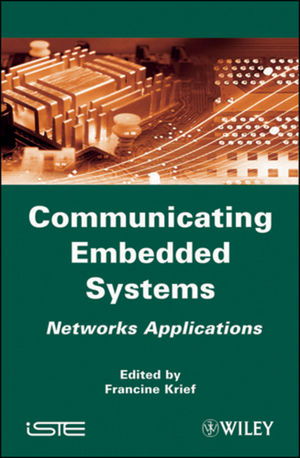Communicating Embedded Systems: Networks ApplicationsISBN: 978-1-84821-144-5
Hardcover
320 pages
February 2010, Wiley-ISTE
 |
||||||
General Introduction xi
Chapter 1. Introduction to Embedded Systems 1
Patrice KADIONIK
1.1. Introduction 1
1.2. Embedded system: a definition 3
1.3. Properties of an embedded system 4
1.4. The significance of Moore’s Law 6
1.5. Embedded systems and the system on silicon 9
1.6. Embedded systems and communications 12
1.7. Embedded systems and security 13
1.8. Embedded systems and time constraints 14
1.9. Embedded systems and free software 17
1.10. Embedded systems and their design 19
1.11. An example of multimedia embedded system design 20
1.12. Conclusion 25
1.13. Bibliography 26
Chapter 2. Quality-of-Service Routing in Mobile Ad Hoc
Networks 29
Zoubir MAMMERI
2.1. Introduction 29
2.2. Mobile ad hoc networks: concepts, characteristics, challenges 31
2.3. QoS routing: general considerations 37
2.4. Best-effort routing protocols in MANETs 47
2.5. QoS routing in MANETs 56
2.6. Conclusion 71
2.7. Bibliography 74
Chapter 3. Self-Management of Ad Hoc Sensor Networks
81
Francine KRIEF
3.1. Introduction 81
3.2. Wireless sensor networks 82
3.3. Autonomic sensor networks 94
3.4. An example of self-configuration 102
3.5. Conclusion 109
3.6. Bibliography 110
Chapter 4. RFID Technology 113
Vincent GUYOT
4.1. Introduction 113
4.2. Automatic identification systems 113
4.3. The components of an RFID system 116
4.4. The different types of RFID systems 118
4.5. RF ranges 120
4.6. Information security 120
4.7. Standards in force 124
4.8. Examples of implementations 127
4.9. Conclusion 136
4.10. Bibliography 136
Chapter 5. Hardware Security in Embedded Systems
139
Lilian BOSSUET and Guy GOGNIAT
5.1. Introduction 139
5.2. Embedded systems and their security issues 140
5.3. Security of the system and its data 147
5.4. Secured hardware architectures for embedded systems 155
5.5. Conclusion168
5.6. Bibliography 169
Chapter 6. Communications Security in Embedded Systems
175
Mohamed Aymen CHALOUF
6.1. Introduction 175
6.2. Communications security 176
6.3. Communications security in embedded systems 195
6.4. Conclusion 204
6.5. Bibliography 204
Chapter 7. Cross-Layer Adaptation for Multimedia Services in
802.11-Type Embedded Communications Systems 207
Ismaïl DJAMA
7.1. Introduction 207
7.2. Limits of layered structuring 209
7.3. The XL concept 219
7.4. Conclusion 231
7.5. Bibliography 231
Chapter 8. Relevance of the DTN Architecture to Mobile Ad Hoc
Networks 235
Olfa SAMET
8.1. Introduction 235
8.2. Mobile ad hoc networks 236
8.3. Challenged networks 239
8.4. Delay-tolerant networks 241
8.5. Relevance of DTNs to ad hoc mobile networks 263
8.6. Conclusion 266
8.7. Bibliography 266
Chapter 9. Intelligent Interfaces and Mobile Communications
267
Badr BENMAMMAR and Zeina EL-FERKH JRAD
9.1. Introduction 267
9.2. Assisting the user with access to new internet services 269
9.3. Modeling user behavior 272
9.4. Synthesis of mobile and wireless networks 276
9.5. References for intelligent interfaces for access to mobile networks 285
9.6. Conclusion 294
9.7. Bibliography 294
Chapter 10. Routing and Mobility Management in Personal
Networks 301
Usman JAVAID and Francine KRIEF
10.1. Introduction 301
10.2. Personal environments 303
10.3. Routing in personal environments 306
10.4. Gateway discovery 311
10.5. Mobility management 314
10.6. Conclusion 319
10.7. Bibliography 319
List of Authors 321
Index 323



